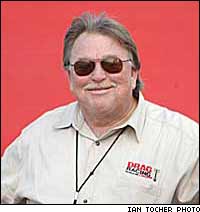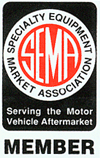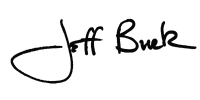|
|||||||||||||||||||||||||||||||||||||||||||||||||||||||||||||

Tune it up, suit up, buckle up and race. . .and stop the whining
10/18/06
 Photo by Ian Tocher |
After the recently completed NHRA national event at Virginia Motorsports Park and during the televised coverage of that event, many racers in the professional ranks savaged the facility’s track surface because it had bumps and was “too porous.” One of my fellow drag racing editors wrote a column calling the track “disgraceful” and we here at DRO got more than a few emails critical of the track.
Now I’m usually on the “bashwagon” when it comes to criticizing NHRA national event sites for not providing the racers (or fans for that matter) a safe and fair racing surface that offers racers at least a chance to win in either lane. So, after watching the race on TV and then reading the post-race racer quotes and reader’s letters on the subject, I thought perhaps I’d missed something, because I thought VMP’s track surface delivered just about everything that any racer or fan could want. The race provided record speeds and ET’s and some of the most entertaining and spectacular racing I’ve seen on TV in years.
As far as performance went, not only did we see the most incredible Pro Stock racing in the history of the NHRA class with Jason Line re-setting the Pro Stock national record at 6.558/209.75, but those in attendance also saw record-setting times in many of the sportsman classes, including a new Alky Funny Car record from “Ace” Manzo of 5.469 ET at 262.44 mph.
More than a few of the letters and rants concerned the unfairness of the track, so I went to the race records to see if one lane dominated the results, and the facts are that while the left lane was preferred by some, some racers chose and won in the right lane. I will admit that many of the final round wins came in the left lane, but having one lane slightly better than another isn’t unusual.
Now I can see you readers already rolling your eyes and muttering something like “He doesn’t race on that circuit or tune a car so where the hell does he get off talking like that?” Well bear with me, as this rant is as much philosophical as it is factual.
In the first round of Top Fuel there were a lot of cars that smoked or shook the tires in the right lane, but there were two of the eight races where that wasn’t the case. Brandon Bernstein (right lane) beat Morgan Lucas with a 4.56 to a 4.63 and Doug Kalitta (right lane) beat Hillary Will 4.58 to a 4.59. In the first round of Fuel Funny Car only two of the eight races didn’t see both car go down the track and almost as many winners came from the right lane as the left.
Then there is Pro Stock. Again, there were a few rounds where one car shook and another didn’t, but in the end after the first round just about as many won from the right as did from the left and both lanes delivered sub-6.60 passes. In the semi-finals right after the first Pro Stock “pedal fest” I’ve ever seen, where Tom Martino and Jim Yates both shook and spun the tires dramatically. The very next pair saw Greg Anderson and Jason Line go down the same track and Line set the national record with a run of 6.588/209.17 to Anderson’s 6.623/209.26. Bad track? I don’t think so.
In my opinion NHRA drag racing can be just way too predictable. To be honest, watching eight pairs of Top Fuelers, Funny Cars, Pro Stocks or Pro Gassers go straight down the track without a bobble bores me to tears. I want to see racing where the tuner’s and driver’s ability to cope with or compensate for track issues has as much to do with determining the winner as who makes the most horsepower. The only reason to pay a tuner or a driver six-figure salaries would be their ability to deliver under adverse conditions. Tuners and drivers at this level are expected to go fast on a perfect track that is billiard table smooth and coated with enough rubber and traction juice on it to pull a shoe off all the way to the finish line. What separates the stars from the journeymen in racing is the ability to rise to the occasion. For me that’s also what makes all racing, especially drag racing, entertaining.
In every other professional motorsport except drag racing, tuners and drivers have to adjust from week to week with extremely different track surfaces, conditions, length, and banking. On the other hand, for the most part the NHRA and their tracks go to great efforts to make the track surface similar from race to race. What all professional drag racing needs, in my opinion, is more variety not less. I vote for less track prep, not more. Varied track surfaces are a good thing. The current NHRA administration and their IHRA counterparts see drag racing as just an open-air bar with the entertainment being drag racing. And they know the fans better like the entertainment or they won’t come in or back. Pedal fests and racer wining who probably shouldn’t is all part of the entertainment.
Drag racing became entertainment instead of a contest for speed and ET about 50 years ago when they quit running cars one at a time through a speed trap and started pairing them off to run each other. And let’s remember that almost from the beginning of the sport they handicapped the cars so that the quickest and fastest car didn’t always win so that the sport would be entertaining and give the “little guy” a chance for the big prize.
I can’t tell you how many racers and team owners have told me over the years that they wanted their drivers and tuners to have a bigger role in deciding who got the win on raceday. But when they were presented with just that opportunity at Richmond on a track that rewarded tuner and driver skill as much as raw power numbers, some of them went on TV instead and cried “foul,” and their fans lined up right behind them, berating the NHRA and the track owners. Shame on all of you.
The facts don’t back up the assertion that the track was a one lane track all day long. The facts show that veteran tuners like Rahn Tobler, Connie Kalitta, Sam Shockley, and Jimmy Walsh to name a few and veteran drivers such as Cory McClenathan (won in right lane all day), Frank Manzo (won race from left lane all day) and Cruz Pedregon did what professional drivers and tuners are paid to do: Take what the track gives them and make the most of it.
|
If you really want to make drag racing a sport where the only thing that matters is who has the biggest wallet, then keep prepping the tracks to within an inch of their life, make them all smooth as glass, and bring in a truckload of liquefied rubber to pour on them. Then just engrave the Top Fuel and Funny Car trophies with whatever driver’s name who drives for Alan Johnson or Austin Coil or Connie Kalitta because no one makes more horsepower than those guys. The only thing that ever seems to slow them down are the tracks themselves. I believe that consistently great tracks would put underfinanced racers out of the sport quicker than any other factor.
For the sport’s survival, let each track have some personality, force the drivers to drive and the tuners to tune, make drag racing real racing not just a contest of speed, ET and bank drafts. If that’s all the fans and the racers really want, we may as well just start running them one at a time. At least then we could probably count on everyone racing in the “good” lane. ![]()


